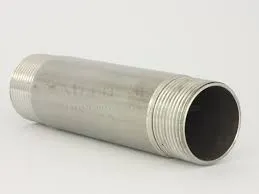-
Cangzhou Yulong Steel Co., Ltd.
-
Phone:
+86 13303177267 -
Email:
admin@ylsteelfittings.com
- English
- Arabic
- Italian
- Spanish
- Portuguese
- German
- kazakh
- Persian
- Greek
- French
- Russian
- Polish
- Thai
- Indonesian
- Vietnamese
- Zulu
- Korean
- Uzbek
- Hindi
- Serbian
- Malay
- Ukrainian
- Gujarati
- Haitian Creole
- hausa
- hawaiian
- Hebrew
- Miao
- Hungarian
- Icelandic
- igbo
- irish
- Japanese
- Javanese
- Kannada
- Khmer
- Rwandese
- Afrikaans
- Albanian
- Amharic
- Armenian
- Azerbaijani
- Basque
- Belarusian
- Bengali
- Bosnian
- Bulgarian
- Catalan
- Cebuano
- China
- China (Taiwan)
- Corsican
- Croatian
- Czech
- Danish
- Esperanto
- Estonian
- Finnish
- Frisian
- Galician
- Georgian
- Kurdish
- Kyrgyz
- Lao
- Latin
- Latvian
- Lithuanian
- Luxembourgish
- Macedonian
- Malgashi
- Malayalam
- Maltese
- Maori
- Marathi
- Mongolian
- Myanmar
- Nepali
- Norwegian
- Norwegian
- Occitan
- Pashto
- Dutch
- Punjabi
- Romanian
- Samoan
- Scottish Gaelic
- Sesotho
- Shona
- Sindhi
- Sinhala
- Slovak
- Slovenian
- Somali
- Sundanese
- Swahili
- Swedish
- Tagalog
- Tajik
- Tamil
- Tatar
- Telugu
- Turkish
- Turkmen
- Urdu
- Uighur
- Welsh
- Bantu
- Yiddish
- Yoruba

Sep . 14, 2024 13:53 Back to list
api 5l spec
Understanding API 5L A Guide to Pipeline Steel Specifications
API 5L, established by the American Petroleum Institute (API), is a standard specification that governs the manufacturing of line pipe used in the transportation of oil, natural gas, and other fluids. The relevance of API 5L extends beyond the petroleum industry, impacting various sectors where high strength and durability of steel pipes are required. This specification ensures that the pipes meet specific mechanical properties, chemical compositions, and dimensional requirements, which are critical for safe and efficient fluid transport.
Key Aspects of API 5L
1. Grades and Types API 5L specifies various grades, primarily categorized into two groups PSL1 (Product Specification Level 1) and PSL2 (Product Specification Level 2). PSL1 is designed for general use, while PSL2 includes additional requirements for mechanical properties, chemical compositions, and testing methods, making it suitable for more critical applications. The grades, such as X42, X52, X60, and X70, indicate the yield strength of the steel in kilopounds per square inch (ksi). Higher-grade numbers suggest better strength and suitability for high-pressure and high-temperature applications.
2. Chemical Composition API 5L outlines specific chemical compositions for the steel pipes to ensure optimal performance and resistance to various environmental factors. These compositions typically include carbon, manganese, phosphorus, sulfur, and silicon, each playing a crucial role in enhancing the mechanical properties of the steel. The standard focuses on balancing these elements to maintain strength while minimizing brittleness and susceptibility to corrosion.
3. Mechanical Properties The mechanical properties of API 5L steel pipes, such as tensile strength, yield strength, and elongation percentage, are critical for ensuring the pipes can withstand the stresses encountered during transportation and installation. The specification provides minimum requirements for these mechanical properties, ensuring the pipe will perform adequately in its intended application.
api 5l spec

4. Testing and Inspection API 5L mandates rigorous testing and inspection protocols to ensure the quality and integrity of the pipes. This includes non-destructive testing methods such as ultrasonic testing and magnetic particle inspection, which help identify any defects or irregularities in the pipes before they are put into service.
5. Applications The applications of API 5L pipes span various sectors, including but not limited to oil and gas pipelines, water distribution, and structural applications. The high strength and excellent corrosion resistance make these pipes suitable for both onshore and offshore installations.
6. International Standards While primarily an American standard, API 5L is recognized and used internationally, influencing global practices in steel pipe manufacturing and quality assurance. This widespread adoption underscores the importance of quality and safety in industries reliant on effective fluid transportation.
Conclusion
API 5L plays a pivotal role in ensuring the reliability and efficiency of pipelines used across different sectors. By adhering to these specifications, manufacturers can guarantee that their products not only meet industry standards but also support the safe transportation of essential resources like oil and gas. As the demand for energy and natural resources continues to grow, the importance of high-quality line pipes specified by API 5L will only become more pronounced, ensuring that pipelines remain a vital component of modern infrastructure.
Latest news
-
ANSI 150P SS304 SO FLANGE
NewsFeb.14,2025
-
ASTM A333GR6 STEEL PIPE
NewsJan.20,2025
-
ANSI B16.5 WELDING NECK FLANGE
NewsJan.15,2026
-
ANSI B16.5 SLIP-ON FLANGE
NewsApr.19,2024
-
SABS 1123 FLANGE
NewsJan.15,2025
-
DIN86044 PLATE FLANGE
NewsApr.19,2024
-
DIN2527 BLIND FLANGE
NewsApr.12,2024
-
JIS B2311 Butt-Welding Fittings LR/SR 45°/90° /180°Seamless/Weld
NewsApr.23,2024











